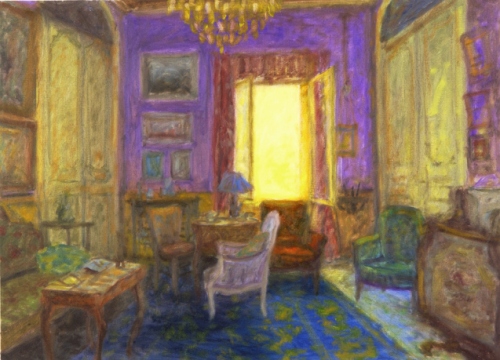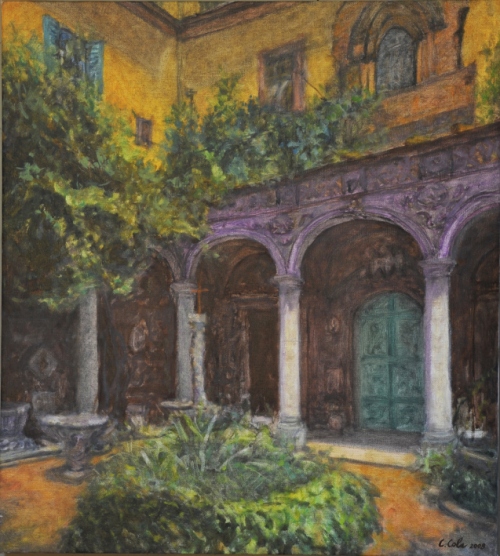Above: one painting by Italian artist Carlo Cola. The Gallerist’s Room
My dear, I knew Carlo Cola time ago and I was vey impressed by his art. I literally fell in love with his paintings. That’s why I want to share with you this post reblogged from Extraordinart. Enjoy it!!!!!
Casanova’s Studio
CARLO COLA
When we first met Carlo Cola In Forlimpopoli, a small town in the heartland of Italy, he welcomed us into his house, a very old osteria (wine shop) he personally restored from scratch and then furnished and painted it with contrasting, bright colors. All of a sudden our heart was warmed by a sort of Barragan’s atmosphere mixed with Indian furniture and carpets from Morocco, with their loud patterns quietly absorbed by the wisdom of antique, crumbling walls. The house – scattered on three floors with a garden, a pond, a terrace overlooking the town’s roofs, and a secret room hidden behind a rotating wall – was just an anticipation because Carlo Cola’s space is not limited to the physical world but continues into a Borgesian ‘Biblioteca de Babel’, with endless rooms painted on large canvas. His technique is vigorous, as if to represent a room Cola required the same energy to actually build it. Once he starts, nothing stops him. The painting imposes absolute compliance and discipline on him. At the end the artist is exhausted and doesn’t touch a brush for weeks, even months.
“It’s not a matter of waiting for the right idea or something like that,” he says. “If I don’t feel to paint, I simply don’t. I haven’t an agent who pushes me to produce a certain ‘amount’ of paintings. I want to be free. To paint is a natural process for me. I always did it, as far as I remember. My learning curve has not been an easy one, and I’m convinced an artist has to face frustration and overcome many difficulties before reaching its plateau. It’s not a matter of inspiration. It’s hard work, mainly, that gives you full control over what you are doing; this is what, ultimately, leads you to master your own technique.”
Standing in front of one of his “rooms” can be hazardous, at times: the risk is to be sucked into the gravitational field of the painting like Alice in Wonderland without ever being able to come out. Under such spell you start moving around this new medium, breathing the oily fragrance of its colors, respectfully tiptoeing for the fear of breaking some depicted objects. May be you are simply afraid to wake up, blinded by the yellow light of an infinite afternoon. You search for hints, but find none because every room is inhabited (apart from you). Yet, you know that notable people once lived and worked right here, and your journey through space turns into one through time. Carlo Cola, each time, pays a tribute to these people’s lives, stepping aside with such grace you almost forget about him. Cola’s heart is spacious as much as the rooms and the absence he’s painting. He lets you stay on your own, so that you are finally able to get in touch with somebody who’s not here anymore, but somewhere else for sure. That’s extraordinary, in terms of generosity. It has something to do – if you excuse demodé idealism – with the Immortality of Art.
Marguerite Yourcenar’s Studio
The Indian Doctor’s Room
The Archeological Museum’s Patio in palermo (Sicily)
Giacomo Puccini’s Studio
The English Writer’s Room
The Soul of the Room
Devonshire
Virginia’s Bedroom










